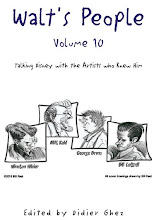 This just in from Jim Korkis:
This just in from Jim Korkis:[A seller on eBay has a great many publicity photos of actress Frances Gifford visiting the Disney Studios in 1941 when she appeared in the live action portion of the THE RELUCTANT DRAGON. I thought this photo (the 5th one in this post) was interesting for profiles of some early Disney employees (isn't that T. Hee in the middle?) but when I enlarged it for a better look, I saw that Gifford was pointing at a storyboard for PETER PAN....obviously a very early version. THE RELUCTANT DRAGON does include a Captain Hook maquette shown as well.]




































3 comments:
RE. photo 5;
Yes, it is T. Hee.
Also in front of him is Bill Cottrell and behind him is John McLeish (John Ployardt)
Vanity post!
Those pictures remind me of my very first visit to the Studios in 1971 (I was a young and impressed lad then!) ...
Miss Gifford is a lovely and pretty lady; I was never that pretty BUT I too had my picture "officially" taken at the famous sign!
Ah, memories!
(Could some storyboards for Peter Pan have been in the works ias early as 1941?)
Love the pics!
FrenchDisneyFan - the answer to your question is yes. I scanned through some of the thousands of Disney related newspapers articles I have on file in my own collection and came up with the following:
In May 1942, The Dunkirk Evening Observer reported: "After release of the completed "Bambi," no more Walt Disney features will reach the screen until at least a year after the war's end. The pressure of war work forced the shelving of "Bongo," "Peter Pan," and "Alice in Wonderland." Production of shorts will continue, but 75 percent of Disney's output already is devoted to Army and Navy training films."
The reason the films were suspended was not because of the war work the Studio was producing, but because foreign markets were closed due to the war.
Before the war, Disney films were distributed to 55 countries. By 1944, three countries (Canada, England and the USA), accounted for about 81% of the company's film revenue.
The war work wasn't done because the Studio wanted to do it, per se. War related projects were solicited because without them, the Studio would probably have gone bankrupt, seeing as though there was no market for their regular entertainment features and shorts overseas.
Post a Comment